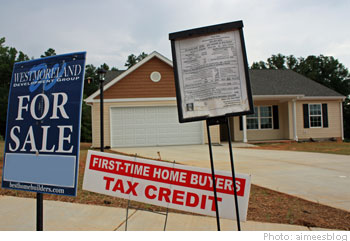 The IRS says that $19 billion of tax credits have been paid. Assume, for the moment, that:
The IRS says that $19 billion of tax credits have been paid. Assume, for the moment, that:
- The credit was well targeted in the sense that (as NAR claims) it reached 1,000,000 persons who would not have purchased a house otherwise,
- These 1,000,000 persons received a credit of $7,000 (close to the maximum of $8k, and equal to the average among those found to be cheating),
- All owner-occupied homes are perfect substitutes with each other,
- Owner-occupied homes are in fixed supply, and
- The persons receiving the credit previously lived in dwellings that are not substitutes for owner occupied homes.
Of the 1,000,000 who supposedly bought homes because of the credit, some of them would have been induced to buy with a much smaller credit (say, $100) and others needed the entire credit. Note that housing prices had to go up LESS than $7000 because the price increase would have just canceled the credit and nobody would have been induced to buy. $3500 is a good guess for the price increase (given the assumptions above), and would be exactly right if marginal potential new buyers were uniformly distributed in terms of their willingness to pay.
The average home in 2009 sold for $217,000, of which $3500 would be 1.6 percent.
1.6 percent is still less than the housing price increase reported by Case-Shiller over the most recent twelve months. So, even if a 1.6 percent impact were not exaggerated, housing prices would have been stable or increasing over the past year even without the credit.
Moreover, the 1.6 percent impact is exaggerated. First, homes were sold to buyers who did not get the credit, and those buyers did not compete directly with buyers who did (for example, vacation homes or larger homes that are typically sold to buyers who already own a home). Those homes count in the housing price index, and had a price impact of much less than $3500.
Second, owner-occupied homes are not in fixed supply — indeed much of the construction activity over the past year has been attributed to the credit (this is an exaggeration too). To the degree that the supply of homes was impacted by the credit, housing prices increased less than $3500.
Third, the persons receiving the credit were living somewhere before they purchased their credit-eligible house. Their former dwelling is on market, pushing down housing prices.
One back-of-the-envelope way to consider all of these effects is that each cuts the price impact in half, so that the price impact is $438 ($3500/8) or 0.2 percent. In this case, the main effect of the credit was to cause a few new houses to be built and a couple of million families to switch swap residences with each other.
Regardless of whether the price impact was $400 or $4000, the fact is that housing prices and construction activity stopped falling a year ago, and it is a wild exaggeration to claim that the pattern would have been much different without the new home buyer tax credit.
- Bulenox: Get 45% to 91% OFF ... Use Discount Code: UNO
- Risk Our Money Not Yours | Get 50% to 90% OFF ... Use Discount Code: MMBVBKSM
Disclaimer: This page contains affiliate links. If you choose to make a purchase after clicking a link, we may receive a commission at no additional cost to you. Thank you for your support!


Leave a Reply